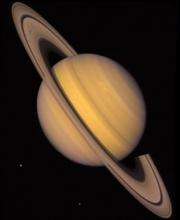STAR TRAK for March: Saturn at its brightest for the year

Saturn will be opposite the sun in our sky on March 21, when it will be closest to Earth in its orbit. Rising in the east at sunset, appearing highest in the south around midnight and setting in the west at dawn, Saturn will be easily visible almost all night during March as it crosses the southern sky, glowing bright yellow among the stars of the constellation Virgo.
An event called the Globe at Night star count, now in its fifth year, has drawn thousands of participants worldwide. This year's count will run from March 3 to March 16 (www.globe.gov/GaN). The purpose is to get the public excited about what can be seen in the night sky -- but to emphasize that many of these celestial sights are being lost to light pollution.
Planets
Saturn will be opposite the sun in our sky on March 21, when it will be closest to Earth in its orbit. It will rise in the east at sunset, appear highest in the south around midnight and set in the west at dawn. Saturn will be easily visible almost all night during March as it crosses the southern sky, glowing bright yellow among the stars of the constellation Virgo. Its rings will be tilted 3 degrees to our line of sight.
Saturn has at least 60 moons, and the largest one, the planet-sized Titan, can be seen with any telescope. For the best telescopic views, wait until Saturn is at least a third of the way up the sky, above most of the turbulence near the horizon. See nasa.gov/home/index.cfm" target="_blank">saturn.jpl.nasa.gov/home/index.cfm for the latest news and images from the Cassini spacecraft orbiting Saturn.
Mars will appear high in the southeast as evening twilight fades during March, conspicuous in the constellation Cancer the Crab.
Venus will shine low in the west as the evening sky darkens during March. It will be a little higher each night, but its brightness will remain about the same all month.
Mercury will pass behind the sun on March 14. By month's end, it will be barely visible below Venus very low in the west a half hour after sunset.
Jupiter will be out of sight on the far side of the sun during March.
Occultation
On the night of March 20-21, the moon will cross the southern part of the Pleiades star cluster, blocking several of its stars. Binoculars will offer the best view of this conjunction.
Equinox
The sun will cross the celestial equator (an extension of Earth's equator onto the sky) on March 20 at 1:32 p.m. EDT (17:32 Universal Time) heading north. This will mark the start of spring in the Northern Hemisphere and fall in the Southern Hemisphere. For the next six months in the Northern Hemisphere, the days will be longer than the nights.
Day and night are not precisely the same length at the time of the equinox. That happens on different dates for different latitudes. At higher latitudes in the Northern Hemisphere, the date of equal day and night occurs before the March equinox. In the Southern Hemisphere, this happens after the March equinox. Information about the exact time of the equinox at different places on Earth's surface is provided at aa.usno.navy.mil/faq/docs/equinoxes.php .
Moon phases
The moon will be at third quarter on March 7, new on March 15, at first quarter on March 23 and full on March 29.
Provided by Indiana University





















